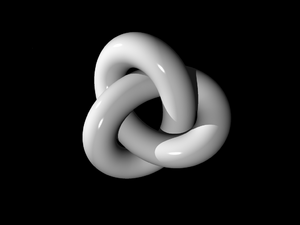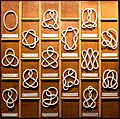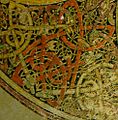Knot theory facts for kids
Knot theory is a cool part of mathematics that studies knots. But not just any knots! In knot theory, the ends of the "rope" are always joined together. This means you can't untie the knot by just pulling the ends. It's like a tangled rubber band that's been glued into a loop. Scientists and mathematicians study these special knots to understand their shapes and how they can be moved without cutting them.
Contents
What is Knot Theory?
Knot theory is a branch of topology. Topology is a field of math that looks at shapes and spaces. It studies properties that don't change even if you stretch or bend something. Imagine a rubber band. You can twist it into many shapes, but it's still one continuous loop. Knot theory focuses on these loops, especially when they are tangled in interesting ways.
The Idea of a Mathematical Knot
In everyday life, we untie knots all the time. But in knot theory, a knot is a closed loop. Think of a piece of string with its ends glued together. Once the ends are joined, you can't untie it anymore. You can only move it around or try to make it look simpler.
Mathematicians want to know if two knots are actually the same. They are the same if you can move one knot into the shape of the other without cutting or breaking it. If you can't, then they are different knots. The simplest knot is called the trivial knot. It's just a simple circle with no tangles at all.
Who Started Knot Theory?
The first person to really study mathematical knots was Peter Guthrie Tait. He was a Scottish physicist who lived in the 1800s. In the 1860s, Tait started drawing and listing different knots. He wanted to create charts that described them. His work helped create the field of knot theory we know today.
Why Study Knots?
You might wonder why mathematicians study knots. It turns out knot theory is useful in many areas!
Knots in Science
- DNA: Our DNA is like a very long, thin string. It can get tangled and form knots inside our cells. Knot theory helps scientists understand how these tangles affect our bodies.
- Physics: Knots can describe how tiny particles behave. They also help explain how energy and forces work in the universe.
- Chemistry: Some molecules can form knot-like structures. Understanding these knots helps chemists design new materials.
Knots in Art and Culture
Knots are not just for math and science. They have been part of human culture for thousands of years.
- Ancient Art: Many ancient cultures used knot patterns in their art. The Book of Kells, an old Irish manuscript, has amazing Celtic knot designs.
- Sailing and Climbing: Sailors and climbers use many different knots. These knots are important for safety and strength. While these are "real" knots, their study can sometimes connect to mathematical ideas.
Other pages
Images for kids
-
Intricate Celtic knotwork in the 1200-year-old Book of Kells
See also
 In Spanish: Teoría de nudos para niños
In Spanish: Teoría de nudos para niños






